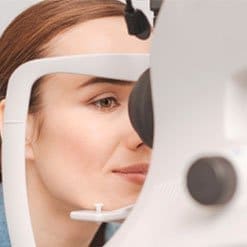Eye defects correction
Table of Content
Surgical methods – described in the part on surgery of eye defects.
We customize all types of contact lenses, both soft and hard. We are able to design individually and order lenses both soft and hard, allowing the correction of all defects of vision, especially:
- Keratoconus
- High astigmatism
- Defects of vision caused by trauma, deformity of the cornea
- Cornea transplants
- Correction presbyopia (presbyopia) – allowing to see well both from distance and near, without extra glasses
- Orthokeratology allows for stability and correction of myopia defects . Patient can see well both with lenses and without them!
Amblyopia and contact lenses
In a situation ,when the eye defect during the development of vision in children is badly or not corrected , the problem of amblyopia arises . Correction of vision defects using glasses in children is problematic. Sometimes it is hard to fit frames to baby’s nose so that the glasses do not fall or do not disturb during games and busy lifestyle of young patients. It is not until many months of using correction that visual acuity is improved . Therefore, the best method of correcting vision defects in children is the use of contact lenses, especially hard ones, as it allows the most precise correction. This principle also applies to adults.
Astigmatism correction
Astigmatism correction can be performed by surgical implantation of toric lens during cataract surgery or simultaneous performing corneal relaxation incision. It is also possible to apply preventive treatment and fit contact lenses, soft or hard.
Astigmatism – and soft contact lenses
Soft contact lenses can compensate for astigmatism in a fairly limited range, usually up to -3 D. Of course ,there are known lenses that allow to adjust individually even up to -11 D cylindrical, but you can never achieve a better vision as with glasses , and such lenses require a lot of work The reason for this is the need for a dynamic movement of the lens on the eye. During these movements lens sways slightly, changing in a different degree, the corrected astigmatism axis. The drawbacks of this practically do not exist in hard lenses. Manufactured currently hard contact lenses allow for correction of all vision defects.
High astigmatism
If astigmatism exceeds 3 D , correction of the defect with the glasses becomes difficult, and patients often do not achieve the full vision. In this situation, the ideal method of correcting are hard contact lenses . It is really important in children, where this method allows for the proper treatment of amblyopia.
Hard contact lenses and corneal cone
Refractive disorder, which is caused by conical cornea is very high. It generates the usual rise of myopia and very high astigmatism, possible for correction by hard contact lenses.
More information about keratoconus
Othokeratology (night lenses)
An interesting form of correction of myopia is Orthokeratology of vision defects. It allows you to compensate for myopia and astigmatism, thanks to the hard contact lenses which are worn at night only. The patient sees well both in lens and without them! It is a method of correcting myopia, particularly important for people with an active lifestyle, practising sports, especially water ones . Recommended especially for people whose performed job does not allow for another form of compensation (the uniformed services: police officers, firefighters, soldiers, special forces, and miners, pilots, etc.)
It is the only proven method of inhibiting the progression of myopia in children and adults.
As with all contact lenses, they must be constantly monitored.
Scope of orthokeratology applicatin:
From 0 do -4,75 D spherical
From 0 do -2,5 D of corneal astigmatism – simple
From 0 do -0,75 D of corneal astigmatism – reverse
How do orthokeratological lenses work ?
Lenses are put on before going to bed at night. These lenses, by gentle pressure,cause a change in the central rays of the cornea, thereby correcting myopia and astigmatism. This method is fully reversible, which means that after giving them up, we return to the starting point.
The lenses are selected with the help of specialized software and modern high resolution videokeratograph
Correction occurs after the first night’s sleep in lenses and after a few nights it usually reaches the full designed value.
Contact lenses for children. Strabismus and myopia
If it is possible, it is recommended for children to use contact lenses.. After the first moments of uncertainty and anxiety caused by a new form of correction, children quickly discover that they are much more convenient and less troublesome than glasses. This applies especially to serious defects . It is particularly important that children with strabismus caused by hyperopia ( plus defect ) use contact lens.. They allow for quick and accurate defect compensation and reduce the angle of strabismus, or even eliminate the need for planned surgery. In myopia, they prevent poor vision and often reduce the speed defect development.
Children after congenital cataract surgery and contact lenses
Treatment of a child after congenital cataract surgery is almost always done by hard contact lenses. In our center we have developed own procedure for selecting such lenses. Thanks to it, the effectiveness and accuracy of matching both the shape and the power is very high.
Strict discipline in keeping treatment of children after cataract surgery gives a chance to see in the future.
Presbyopia
Presbyopia ( sight in old age ) – usually when you are over 40, there appears a problem with an acute vision of near objects . People over 45 years of age frequently start using glasses as additional correction for reading . Current technology , however, allows to solve this problem through the use of special multifocal lenses both soft and hard . In soft lenses, optical focus for distance and near vision are arranged concentrically . This allows to achieve a certain compromise between the comfort of distance vision and near vision , thus making it possible to quit wearing glasses. Hard lenses are manufactured as bifocal and progressive , giving full vision both for distance and near vision . They are recommended for the more demanding patients , for whom the convenience of getting rid of glasses is as important as the perfect vision.
Contact lenses and allergy
The use of lenses in people who suffer from allergies it is now possible , but absolutely must be carried out by an eye doctor.
Deformities of cornea, scarring, degeneration
Deformities of cornea, scars and degeneration – in those states, frequently, the only possibility to achieve useful vision is the application of hard contact lenses which are individually designed.
Both eyes are examined
Both eyes are examined
Both eyes are examined






